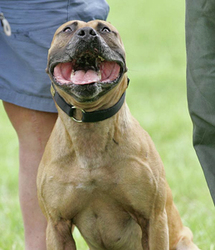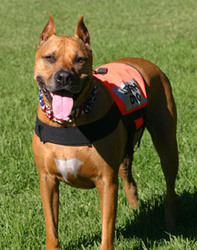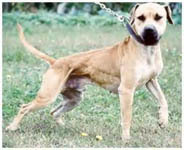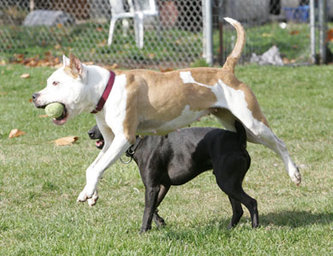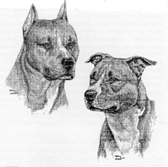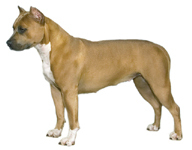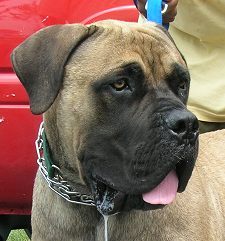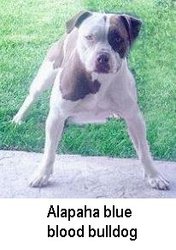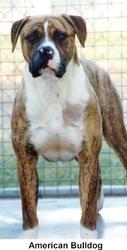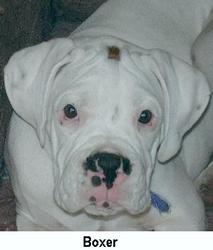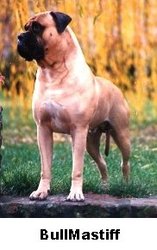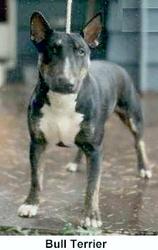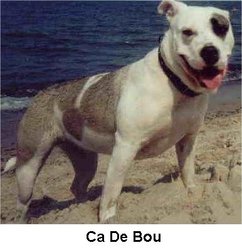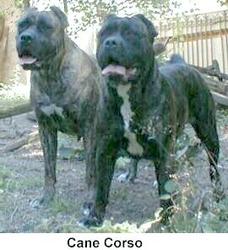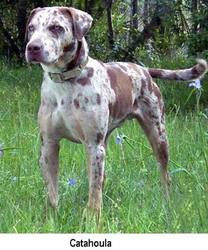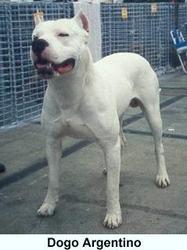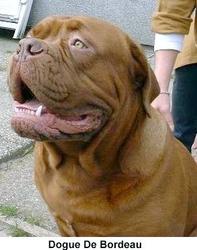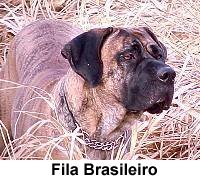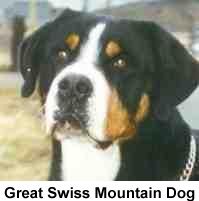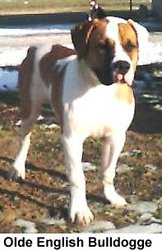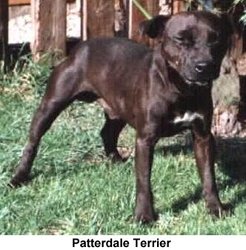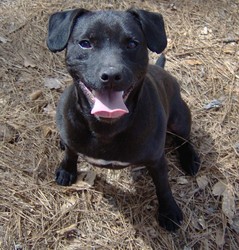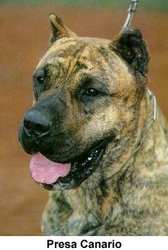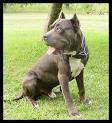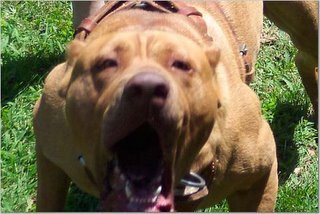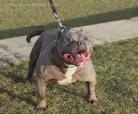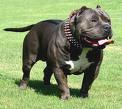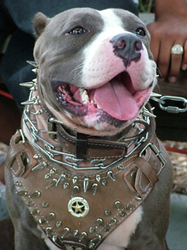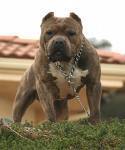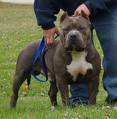It's a pit bull... Right?
In identifying any breed, there are many different characteristics that can be identified, and used to make a guess at what breed a dog is. Unfortunately, people are often wrong as many times as they are right. Often, the characteristics people look for to identify a pit bull can be seen in many other breeds, and sometimes are not even common to pit bulls. These characteristics are usually:
-Big heads with short, square muzzles
-Cropped ears
-Almond eyes
-Brindle in color
-Patches of color on white
-Large in size
-Muscular build
-Docked tails (not common to pit bulls)
-Merle in color (not an acceptable color for a pit bull)
-Any aggressive or mean dog
-Big heads with short, square muzzles
-Cropped ears
-Almond eyes
-Brindle in color
-Patches of color on white
-Large in size
-Muscular build
-Docked tails (not common to pit bulls)
-Merle in color (not an acceptable color for a pit bull)
-Any aggressive or mean dog
UKC Breed Standard
- The American Pit Bull Terrier is a medium-sized, solidly built, short-coated dog with smooth, well-defined musculature. This breed is both powerful and athletic. The body is just slightly longer than tall, but bitches may be somewhat longer in body than dogs. The length of the front leg (measured from point of elbow to the ground) is approximately equal to one-half of the dog’s height at the withers. The head is of medium length, with a broad, flat skull, and a wide, deep muzzle. Ears are small to medium in size, high set, and may be natural or cropped. The relatively short tail is set low, thick at the base and tapers to a point. The American Pit Bull Terrier comes in all colors and color patterns except merle. This breed combines strength and athleticism with grace and agility and should never appear bulky or muscle-bound or fine-boned and rangy. Above all else, the APBT must have the functional capability to be a catch dog that can hold, wrestle (push and pull) and breathe easily while doing its job. Balance and harmony of all parts are critical components of breed type.
Very Serious Fault: Any disproportionate overdone characteristic (such as short legs, excessive bone or massive head or body) that would interfere with working ability.
APBT Look-alikes
The above photo gallery demonstrates one reason why breed should never have a place in the recording of bite reports. It is too easy to mis-identify a breed, and skew the statistics.
--------------------------------------------------------
Bandogs
The term "Bandog" was used in the Middle Ages to denote dogs used in the British Isles as home guardian dogs. Now, it often denotes the crossing of mastiffs with the american pit bull terrier. These dogs weigh upwards of 100 lbs, and often lose the pit bull's even temperament, and become highly protective of their family and home. Many people believe these dogs to be the perfect protection dog and working class guard dogs. Various programs have used American Pit Bull Terrier, American Staffordshire Terrier, and Neapolitan Mastiff crosses. A few programs have also used other bully type breeds as well as other mastiff type breeds. The Bandog, any variety, is strictly a working breed and should be a result of serious and dedicated planning, starting from careful selection of parent breeds and more importantly, appropriate representatives of those breeds, with the health and temperament testing being on the top of the list of priorities, while the uniformity in appearance is the last of the breeders' concerns. The intention in each case is to combine the courage and tenacity of an American Pit Bull Terrier with the large size and guarding instinct of a Mastiff. Like with all dogs, the Bandog can display either the best or the worst characteristics of the parents (or the parent breeds), depending on the knowledge of the breeder and the randomness of genetics.
The following is adapted from WIKIPEDIA, and is just an estimated expected average range of various foundations breeds commonly seen in various Bandog programs.
The Primary Group , approximate average of 25-75% from American Pit Bull Terrier and/or American Stafforshire Terrier.
The Secondary Group ,approximate average of 25-75% from Mastiff and/or Neapolitan Mastiff.
A Tertiary Group (used in some programs) approximate average of 0-75%: American Bulldog, Boerboel, Bull Mastiff, Bulldog Campeiro, Bull Terrier, Cane Corso, Dogue de Bordeaux, Fila Brasileiro, Great Dane, Perro de Presa Canario, and/or the Tosa Inu.
Obviously, in the wrong or inexperienced hands, these dogs can do a lot of damage. Unfortunately, many unscrupulous breeders are selling these dogs to the first buyer, and many owners wind up with an uncontrollable, poorly bred, and dangerous dog.
The following is adapted from WIKIPEDIA, and is just an estimated expected average range of various foundations breeds commonly seen in various Bandog programs.
The Primary Group , approximate average of 25-75% from American Pit Bull Terrier and/or American Stafforshire Terrier.
The Secondary Group ,approximate average of 25-75% from Mastiff and/or Neapolitan Mastiff.
A Tertiary Group (used in some programs) approximate average of 0-75%: American Bulldog, Boerboel, Bull Mastiff, Bulldog Campeiro, Bull Terrier, Cane Corso, Dogue de Bordeaux, Fila Brasileiro, Great Dane, Perro de Presa Canario, and/or the Tosa Inu.
Obviously, in the wrong or inexperienced hands, these dogs can do a lot of damage. Unfortunately, many unscrupulous breeders are selling these dogs to the first buyer, and many owners wind up with an uncontrollable, poorly bred, and dangerous dog.
------------------------------------------------
The American Bully
American Bullies are a new mixed breed invention that sprang from mixing English Bulldogs and/or Neopolitan Mastiffs with pit bulls to get a low-rider style brand of dog. Most people who love a true American Pit Bull are frustrated, as many of the dogs that should be labeled as American Bullies are still being called, and registered as, APBT's. Their kennel club is located at http://www.abkcdogs.org/
A brief history of the breed, taken from DLKBullies.com:
"About 10 years ago some breeders decided they wanted to take the [American Pit Bull] breed in another direction. They bred for the athletic muscular build of the American Pit Bull, but the size and mass of the "Am. Staffs". These dogs were not bred to be as dog aggressive as the Pit, but not as passive as the Am Staff. They were bred for personality, character, energy, drive, unlimited stamina, and that confident stability. They were to have the look of a buff athlete. Through generations of breeding they developed a new look and it adopted the slang name "Bullies". This was the start of a new breed and a new era for "The American Bully". The standard for the bully is a medium height and length. They should have larger blocky shaped heads. Muzzles should be relatively short and blocky. Their chest should be wide and deep with a look of power. Shoulders should be set wide and have a muscular definition. Their rears should be thick and muscular. This breed should represent strength and power from head to tail. When you look at these dogs you should immediately know that it is an "American Bully"." -Dave Wilson of Atomic Dogg Magazine, April 2006 issue [2]
"About 10 years ago some breeders decided they wanted to take the [American Pit Bull] breed in another direction. They bred for the athletic muscular build of the American Pit Bull, but the size and mass of the "Am. Staffs". These dogs were not bred to be as dog aggressive as the Pit, but not as passive as the Am Staff. They were bred for personality, character, energy, drive, unlimited stamina, and that confident stability. They were to have the look of a buff athlete. Through generations of breeding they developed a new look and it adopted the slang name "Bullies". This was the start of a new breed and a new era for "The American Bully". The standard for the bully is a medium height and length. They should have larger blocky shaped heads. Muzzles should be relatively short and blocky. Their chest should be wide and deep with a look of power. Shoulders should be set wide and have a muscular definition. Their rears should be thick and muscular. This breed should represent strength and power from head to tail. When you look at these dogs you should immediately know that it is an "American Bully"." -Dave Wilson of Atomic Dogg Magazine, April 2006 issue [2]
